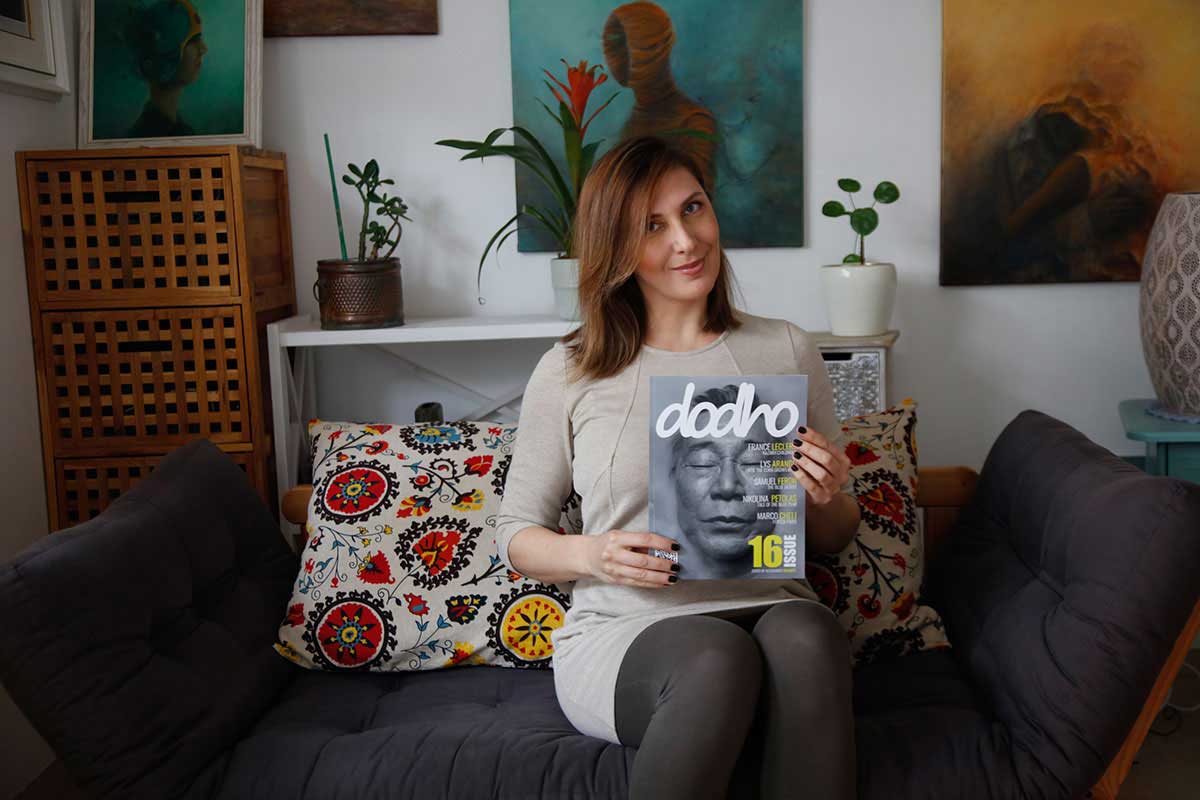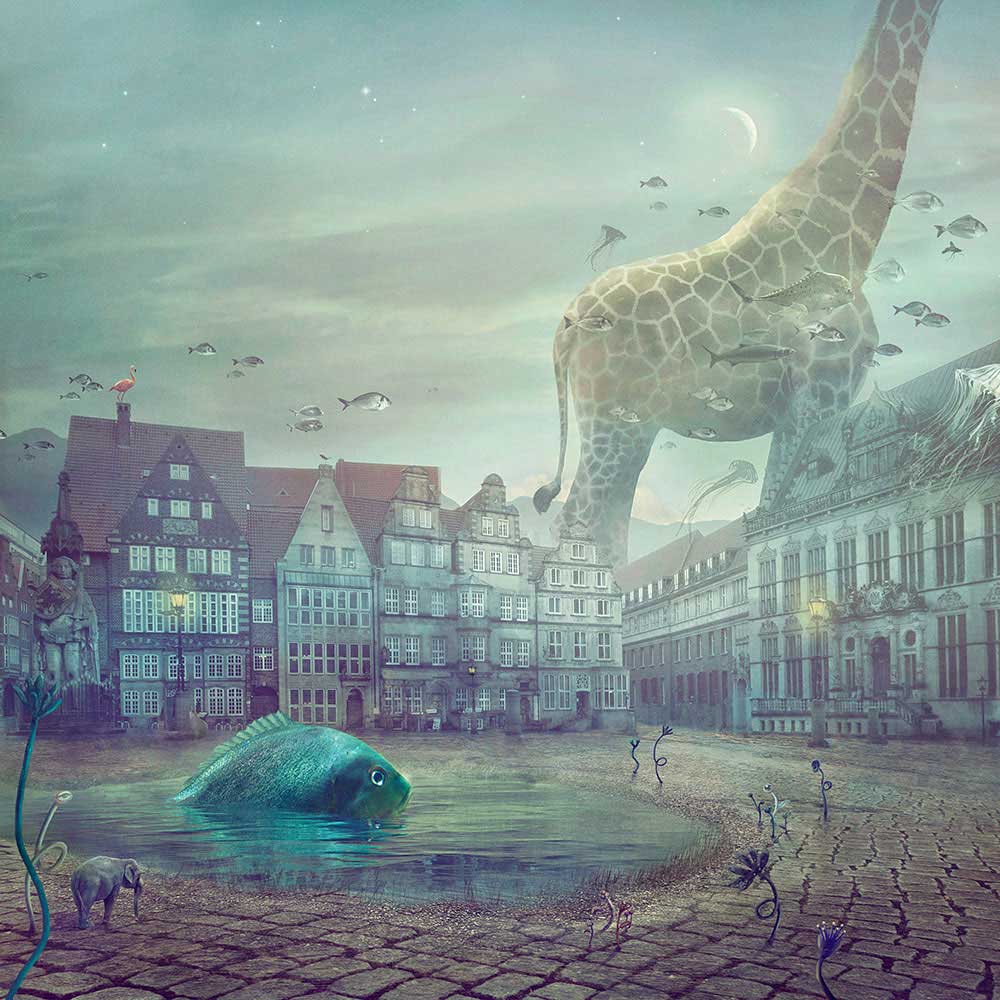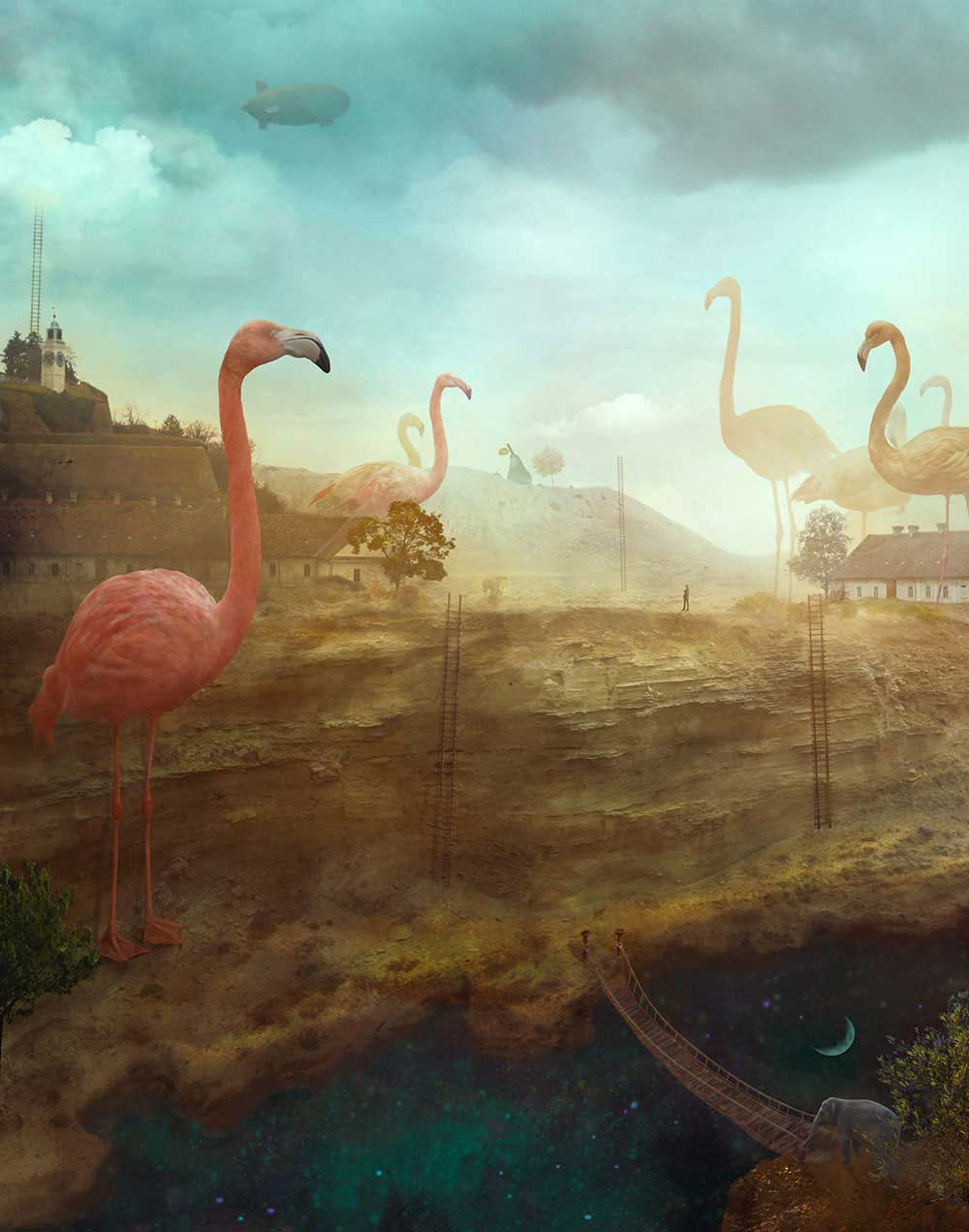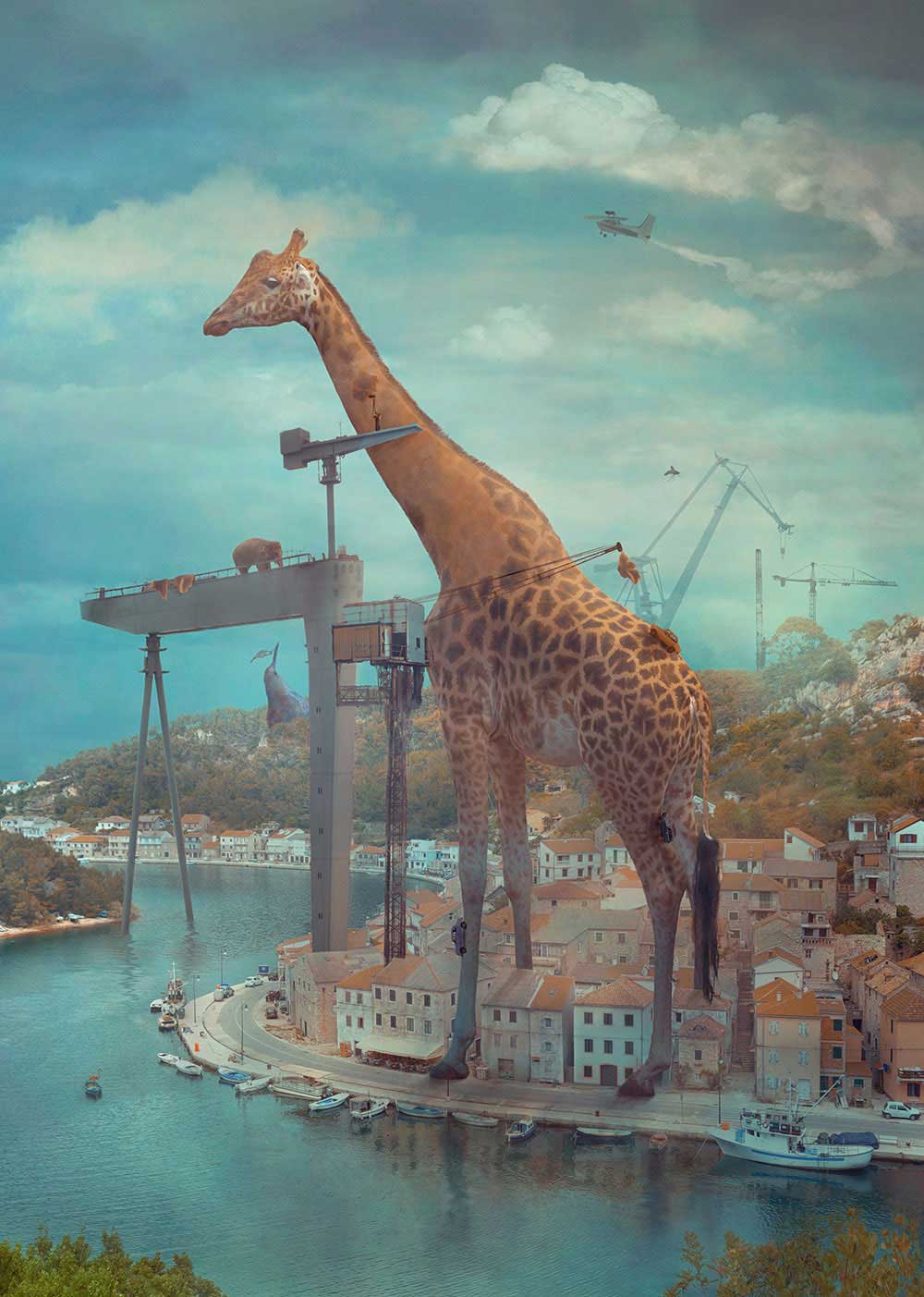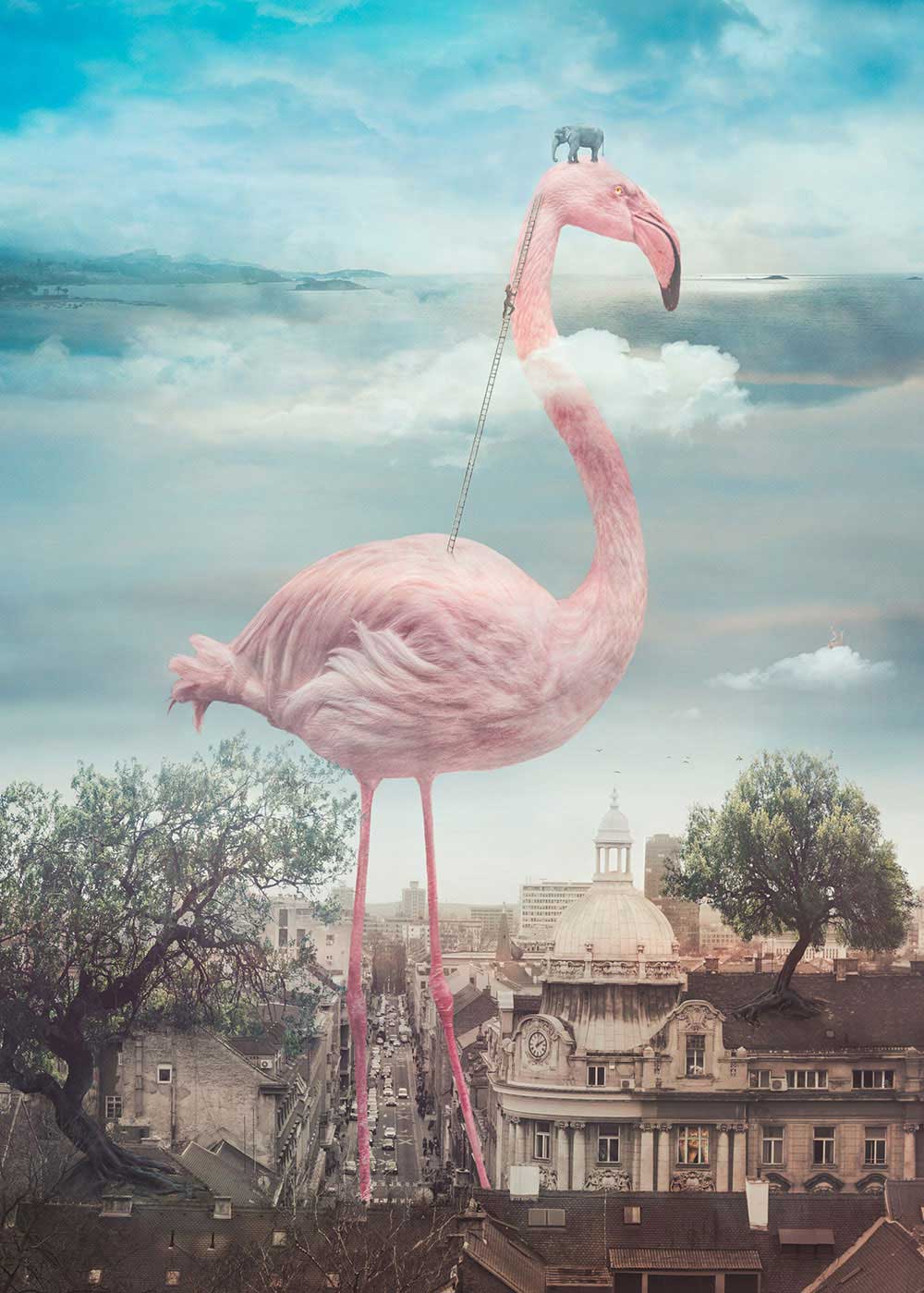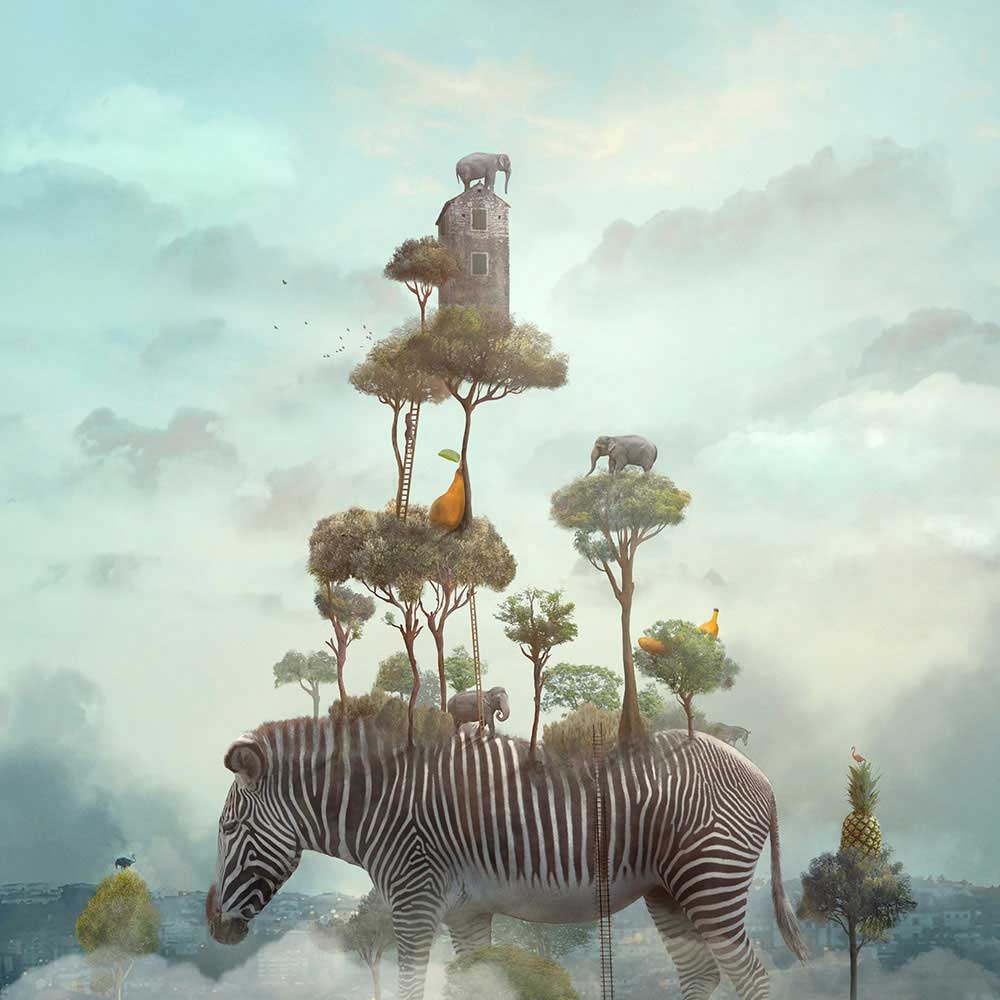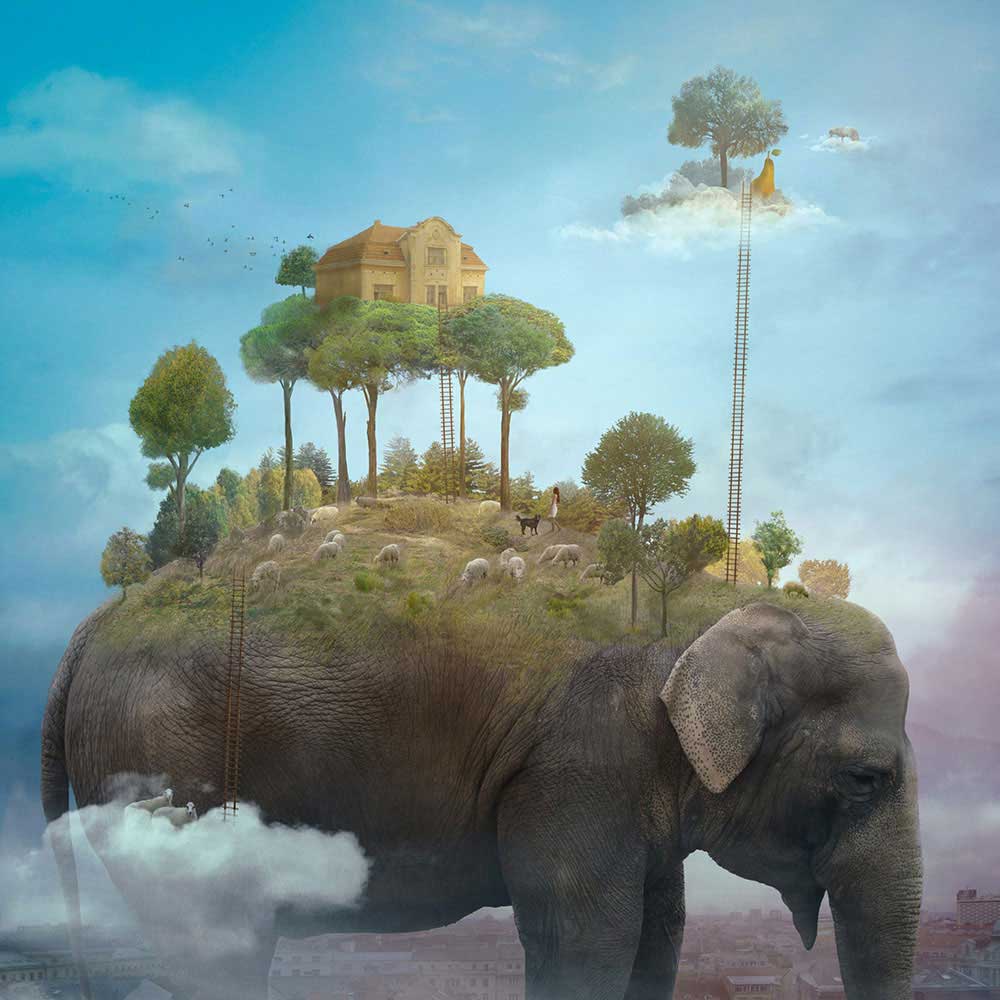Discovering the magic universe of Croatian artist Nikolina Petolas has been a joyful trip. I’m sure you will be intrigued by her skillful mixed techniques and surprised by the sublime beauty she shows in her works.
The animal and human worlds occupy new dimensions as a metaphor of our relationship, and with a meaningful purpose behind that makes us reflect about this connection. Welcome to the land of Nikolina Petolas, I hope you enjoy the views as much as I have. [Official Website][Printed Edition][Digital Edition]
The first feature that attracts the attention of your beautiful imagery is the amazing use of mixed techniques: photo collage, digital art, oils, and acrylics. During my research about your projects, I have been sharing your works with all my contacts and everybody wonders about your process of work. Can you tell us which is your starting point from a technique view? How do you create this wonderful work?
I work in several techniques, but what you are reffering to in ’Tale of the Blue Pear’ series are mostly digital collages combined with digital painting. I also paint in traditional techniques but that is done on canvas or hard board. My collages are mixed digital media created from my own photography which I’ve been taking over the past 15 years. I stitch hundreds of photography parts and also combine them with illustration so I would achieve the surreal sceneries and the dreamy mood.
I’ve seen you are from Zagreb, it is one of the most well-known European cities in Europe for its unique and distinct flavor for the arts. How would you define your relationship with this place? Has it influenced your work? And what would you recommend about the city from an arty perspective?
Zagreb is an interesting city with architectural combination of buildings from socialist era as well as the old city part. I would recommend seeing both, but especially the old part of town, and the upper old town which is very beautiful, with tiny old houses and wonderful panoramic view. There are also many galleries in the old part of town which have interesting shows. Some of my artworks are photographed in that part as it is very inspirational.
Our surroundings surely influence us in every way, so Zagreb influenced some of my work as well. However, I was mostly living in my own little world, composing imaginary surroundings, which cannot be found in reality.
You play with dimensions and perspectives to magnify the animals, transforming them into magical creatures. How do you want to portray them? What’s the intention behind this form you have chosen? And just another curiosity about your connection to animals, which is your favorite one?
Animals is my work have different role than the one we usually are familiar with. I love to portray them as equal characters, often personified, reminding me of some person or individual. The worlds I create are like one giant stage with animals as main actors. Some of them usually repeat in my work, disappearing and then reappearing again. I love using the same characters in my work, which are once settled in one environment and then they continue the story in the other setting.
They are mostly shown in allegorical meaning, showing us also how life is going on in nature when we are not looking. I love to emphasize the importance of animal world and nature, as the world to where we are heading doesn’t look very promising. By placing them in their gigantic form they are shown as creatures of utmost importance.
My love for animals also comes from childhood days, when I was having all sorts of animals as beloved pets. I also practiced horse riding, so I love to use these animals as participants of my surreal worlds. Things we experience as children have an impact to who we are today, so I guess these creatures decided to show themselves in my adulthood, but in some other form.
Every animal is unique in it’s own way. I cannot specify any preference, but with dogs I think there is always that special bond. If I would have to choose the wild life, then birds are one of the most magnificent creature, because, well…the can fly. I don’t know what can beat that.
From a compositional point of view, what comes first in your imaginative process the animal or the context in which you place it? What do you visualize earliest?
Scenery is very important and I spend most of the time creating the scene itself. Of course, I also have in mind a specific animal, but that can also change during the process. The whole process is quite prone to changes. Giving time for an artwork to come together, seeing it with fresh eyes always gives another perspective and also some new ideas on how to make it better. It is all a really fine tuning of every element until it eventually all comes together.
At the content level, you bring odd and unexpected relations to present metaphors of current issues. The human presence sometimes faces the animals in idyllic and paradisiac landscapes, other times we feel human constructions contrasting or even disturbing the animal kingdom. Your messages are surprising and intriguing. What critical ideas are you looking forward to expressing with your images?
Art is a reflection of our surroundings, desires and fears. Sometimes it is symbolic and other times it’s more obvious. It is a way of exploring certain themes as well as an artist’s own mind. My works are fantasy, imaginary stories. They are also a reflections of thoughts, dreams and imagination. However, it is also hard to stay blind to everything that is going on around us. Overpopulation, destruction of nature, endangered species…I guess all that is in a way present in my work, whether placed consciously or unconsciously.
In my body of work ‘Tale of the Blue Pear’ animals have the most important role. Their world exists in harmony with ours. They enhibit human habitats. I guess with oversizing them I also specify their importance as well as the one of the nature. Sometimes they are presented as animals as we know them, but sometimes they are placed there as participants of a modern fable.
The series is kind of (anti)utopia. Everything seems in harmony and idilic, like some modern fairy tale, but things can turn for the worse in a moment. I love art that is subtle and not very obvious. There are characters in my work which raise questions about their existance. We don’t really know if they’re good or bad, and if their connection to their surroundings is clearly positive. It is important for me to connect my art to the things I experienced though life, or to reflect some observation or even distant memory. It is a reflection of past and present, of visions of the future. I cannot see it separated from experiences and events that led us to what we are today.
When I look at your works, I think of various and different artists, art pieces, and movements: Dalí, the surrealist movement, Alice in Wonderland, Mark Ryden, Hieronymus Bosch, Michael Jackson iconography (Moonwalk the film, some of his videos like Earth Song, the cover artwork of Dangerous), Madonna music videos like Dear Jessie or Bedtime Story, the tale Jack and the Beanstalk, Simona Peres and Andrea Ganuza. Which are your main artistic influences? And which artists do you admire?
There are so many wonderful artists that I admire it is hard to mention them all. Of course, Dali and the surrealist movement with other amazing painters such as Max Ernst, Remedios Varo, Leonora Carrington are just a few that made a great influence. Hieronymus Bosch and Peter Brugeel the Elder are one of the great painters that made an eternal stamp with their work. Jacek Yerka and some other polish painters are the brilliant representatives of contemporary surrealism. I enjoy very much the concept art and production sets created in many wonderful movies and games, especially in sci-fi and fantasy environments. I also admire darker artists such as Beksinski and H.R. Giger.
One of the aims of your works is that viewers pause from the world’s pace. How do you manage social networks and their big influence on our lives? What’s your relation to them?
Social media is nowadays very important, but also very time consuming. To find your spot under sun there, you either have to be lucky or have a strong strategy on how to build a following community. I can’t say that I have enough time to be so active there as one needs to be. It is also very hard not to get consumed by social media. Finding balance is very important.. It is our present and honestly I don’t know the recipe how to manage between being active and how to get away from it. I try not to carry my phone when it is not essential, to be present in the moment, or to step into my art world, and see what’s going on in there while I was away.
Finding that sweet spot between virtual and real world is essential.
Your work has gained multiple international awards and has been shown in numerous international exhibitions. It has also been exhibited globally, in galleries and museums of Europe, the USA, and Asia, most recently being exhibited at an individual exhibition in Paris. You have received great recognition worldwide for your body of work, how do you feel about this exposure? And what piece of advice would you give to new creators who are looking for a theme, a style, or simple to improve their work?
Due to the online presence I’ve been invited to exhibit worldwide, either as a part of art projects, festivals or exhibition. But there are also art competitions and calls for artists where an artist can apply and try to participate in a show or a festival. I love to exhibit as this is the way how people can see your work in person, which is quite a different experience than seeing it on screen. It is also a great way to meet new people, talk about art and experience something new. Exhibitions can be stressful and costly but also very rewarding.
My advice would be to experiment and try what interests you, but try to stick to something. It is ok to have different themes or to try other mediums, but it is also important to have something that audience can connect to the creator. I think style comes with time. It is very rare to have a specific style from the very beginning. It is important to do what you love as that themes that you’ll explore will be with you in the years that come. I see many times artists doing what is trendy, but trends come and go. And then when it is gone, you are back to the beginning. The most important thing is to enjoy and have fun!
Seigar
Seigar is a passionate travel, street, social-documentary, conceptual, and pop visual artist based in Tenerife, Spain. He feels obsessed with the pop culture that he shows in his works. He has explored photography, video art, writing, and collage. He writes for some media. His main inspirations are traveling and people. His aim as an artist is to tell tales with his camera, creating a continuous storyline from his trips and encounters. He is a philologist and works as a secondary school teacher. He is a self-taught visual artist, though he has done a two years course in advanced photography and one in cinema and television. His most ambitious projects so far are his Plastic People and Tales of a City. He has participated in several international exhibitions, festivals, and cultural events. His works have been featured in numerous publications worldwide. His last interests are documenting identity and spreading the message of the Latin phrase: Carpe Diem. Recently, he received the Rafael Ramos García International Photography Award. He shares art and culture in his blog: Pop Sonality.



